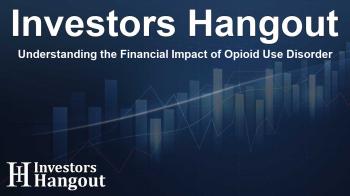Understanding the Financial Impact of Opioid Use Disorder

Opioid Use Disorder: A Growing Concern
Opioid use disorder (OUD) has become a pressing issue in recent years, burdening taxpayers and local communities with substantial costs. According to compelling research, states and local governments allocate over $94 billion each year towards addressing the consequences of opioid misuse. This staggering figure underscores the urgent need for efficient treatment solutions and enhanced public health strategies.
The Financial Toll of OUD
The recently published study highlights the considerable financial burden that OUD inflicts on various sectors. The findings indicate that states like Massachusetts, Kentucky, Nevada, and New Hampshire exhibit the highest rates of opioid use disorder. These states experience escalating costs associated with healthcare, law enforcement, and social services.
Understanding Opioid Use Disorder
OUD is characterized by a persistent need to consume both prescribed and illicit opioids, leading to considerable distress and dysfunction in daily life. Research estimates that approximately 6.1 million people in the U.S. suffer from OUD. Alarmingly, only about one in four individuals diagnosed with the disorder receives the treatment recommended by health professionals.
Barriers to Treatment
Despite the well-documented benefits of therapy for OUD, many individuals face significant obstacles when seeking help. Stigmas surrounding OUD, along with inadequate training for healthcare providers and geographic disparities in access to treatment facilities, create challenges for those in need. Margaret Scott, a Principal at Avalere Health, emphasizes the importance of addressing these barriers to improve care options for affected individuals.
Modeling Costs and Savings
Avalere Health conducted an in-depth analysis focusing on the costs involved in managing OUD, revealing that the national average expenditure per individual case of OUD is nearly $700,000, with more than $150,000 attributed to government, businesses, and families. The study assessed different treatment models, including behavioral therapy and long-acting injectable buprenorphine, identifying that combined treatment strategies could yield substantial cost savings. Specifically, the analysis noted an estimated annual saving of $295,000 per case when utilizing the most effective therapeutic approaches.
Detailed State Comparisons
Among the states facing the most significant challenges due to OUD, the total costs associated with treatment and intervention have been outlined as follows:
- Massachusetts: Total cost of approximately $144.9 billion, with about $4.3 billion coming from federal funding.
- Kentucky: Annual costs near $95.5 billion, with federal contributions at $3.2 billion.
- Nevada: Costs around $47.1 billion, with federal investments nearing $1.8 billion.
- New Hampshire: Total expenditures estimated at $31.4 billion, with federal aid of approximately $908 million.
Public Health Strategies and Future Directions
The findings advocate for a strong emphasis on public health initiatives aimed at reducing the healthcare costs associated with opioid use disorder. As local governments seek innovative solutions to healthcare expenditures, prioritizing effective OUD treatments can lead to significant long-term savings. Michael Ciarametaro, Managing Director at Avalere Health, stresses the vital role of cooperation among health authorities, governments, and insurers to effectively combat the opioid crisis.
Frequently Asked Questions
What is opioid use disorder?
Opioid use disorder is a medical condition characterized by a compulsive need to consume opioids, resulting in significant distress and impairment in everyday life.
How much do states spend on opioid use disorder annually?
States and local governments collectively spend over $94 billion each year to manage the impacts of opioid use disorder.
What are the barriers to effective treatment for OUD?
Barriers include stigma, insufficient healthcare provider training, limited access to treatment facilities, and geographic disparities.
What treatment strategies are most effective for OUD?
The most effective treatment combinations involve behavioral therapy and medications like long-acting injectable buprenorphine, showing promising annual savings.
Why is OUD a public health concern?
OUD significantly affects not just individuals, but also families, communities, and the overall healthcare system, resulting in heightened costs and societal challenges.
About The Author
Contact Ryan Hughes privately here. Or send an email with ATTN: Ryan Hughes as the subject to contact@investorshangout.com.
About Investors Hangout
Investors Hangout is a leading online stock forum for financial discussion and learning, offering a wide range of free tools and resources. It draws in traders of all levels, who exchange market knowledge, investigate trading tactics, and keep an eye on industry developments in real time. Featuring financial articles, stock message boards, quotes, charts, company profiles, and live news updates. Through cooperative learning and a wealth of informational resources, it helps users from novices creating their first portfolios to experts honing their techniques. Join Investors Hangout today: https://investorshangout.com/
The content of this article is based on factual, publicly available information and does not represent legal, financial, or investment advice. Investors Hangout does not offer financial advice, and the author is not a licensed financial advisor. Consult a qualified advisor before making any financial or investment decisions based on this article. This article should not be considered advice to purchase, sell, or hold any securities or other investments. If any of the material provided here is inaccurate, please contact us for corrections.

